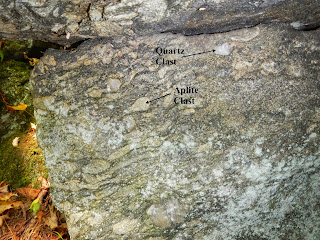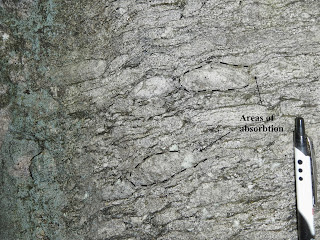Field trip Stops:
Stop 3.1 - Hoosac Schist
The Hoosac contains muscovite, quartz, and albite plagioclase (which is dark gray from graphite inclusions). After the first period of plagioclase crystal growth, the graphite was flushed out of the matrix. If a plagioclase crystal continued to grow after this flush, it could no longer draw in graphite, which is why some of the crystals have a white, graphite-less rim. The Hoosac contains alternating dark and light layers have been folded extensively (Fig. 3.1). It is unlikely that these layers are related to original bedding.
 |
| Figure 3.1. Extensive folding and intense foliation characterize the Hoosac schist |
Stop 3.2 - Rowe Schist
A fine-grained schist that is silvery and spangly. Contains thin layers which are less uniformly dark and light than those in the Hoosac. This is a more aluminous rock than the Hoosac, and probably doesn't contain any albite (all the Na went into forming paragonite).
Stop 3.3 - Rowe Schist
Here the Rowe is still fine-grained, and it is difficult to mineral grains without a hand lens. The mica-rich layers look similar to those at Stop 3.2, However, there are also a lot more quartz layers here than in the schist at stop 3.2 (Fig. 3.2). If this quartz was deposited as sediment, then this can't be a deep water rock, as the transportation potential is too low out in the ocean to transport and deposit quartz grains.
 |
| Figure 3.2. Notice the high density of white quartz layers within the boxes. |
Stop 3.4 - Cruddy Black Schist
The Cruddy Black Schist is an extremely weathered rock that contains a lot of graphite that breaks easily along mica layers. Also contains many quartz layers and iron carbonates. The presence of these minerals indicates that this rock was not deposited in deep water. Black shales usually occur in anoxic environments or from rapid deposition of sediment creating a temporary anoxic environment.
 |
| Figure 3.3. Contact between the lusturous Rowe on the right and the Cruddy Black Schist on the left (outlined by dashed black line). |
Stop 3.5 - Ultramafics
Very fine grained rock with a greenish color (Fig. 3.4) that can most easily be seen when rock is wet. Many people like to think of this as the product of a suture zone right at the ocean edge. Could also be a bit of mantle upwelling near the continent during rifting.
 |
| Figure 3.4. The darker green color is the fresher ultramafic surface (examples in boxes). |
Stop 3.6 - Moretown
The Moretown is a combination of mafic (derived from basalt) and pelitic (derived from sediment) schists, but the contact between the two schist types is never clear cut (Fig. 3.5). The mafic schist has a massive texture, while the pelitic schist is a pinstripe rock with quartz and mafic layers. The Moretown contains many quartz veins such as those seen in Fig. 3.5, which are often accompanied by large pyrite crystals (Fig. 3.6).
 |
| Figure 3.5. Mafic schist on the left with pelitic schist adjacent. Contact highlighted by dashed black line. |
 |
| Figure 3.6. Large pyrite crystals with some chalcopyrite, formed right on a quartz vein. |
Summary
On this field trip we travel away from the Laurentian passive margin
that we saw in Trip 1, and move into the deeper water of the continental
slope-rise. Traditionally, the Hoosac schist has been interpreted as a
member of the slope-rise facies, while the Rowe has been thought of as a
deep ocean deposit. In a deep ocean deposit, you expect more clay
minerals and less quartz because of the lack of transport potential out
in the deeper ocean. However, many units within the Rowe are
quartz-rich, which signifies that it may have been deposited closer to
the continent than traditionally thought.







































